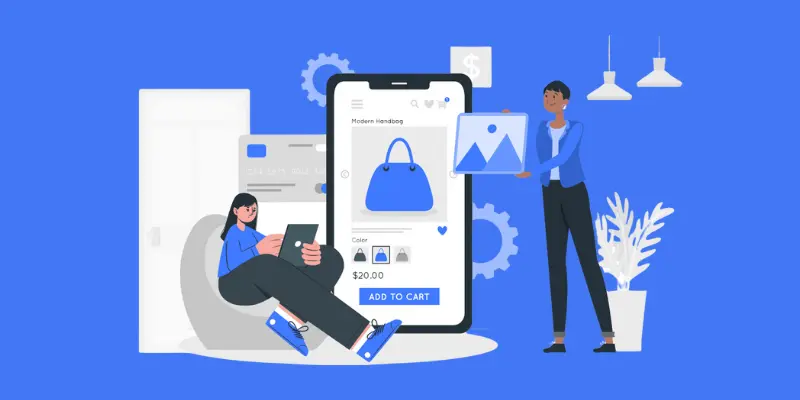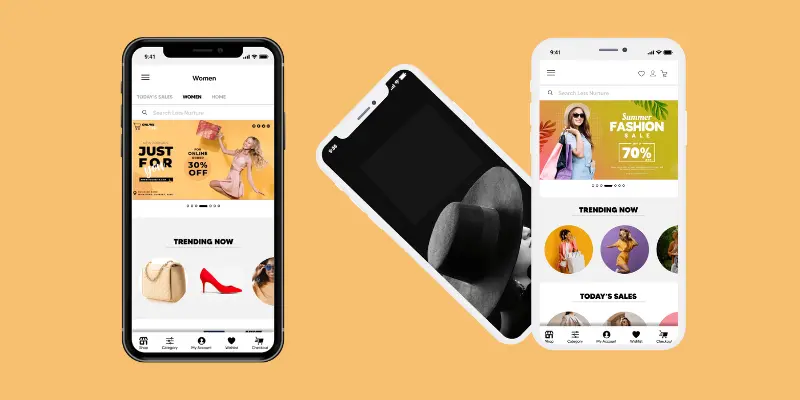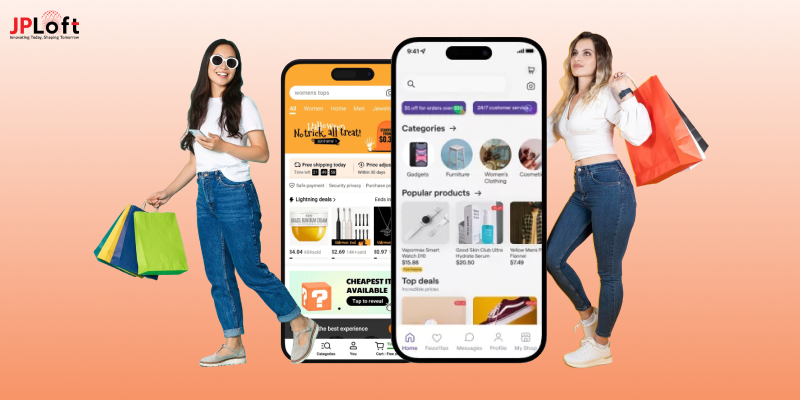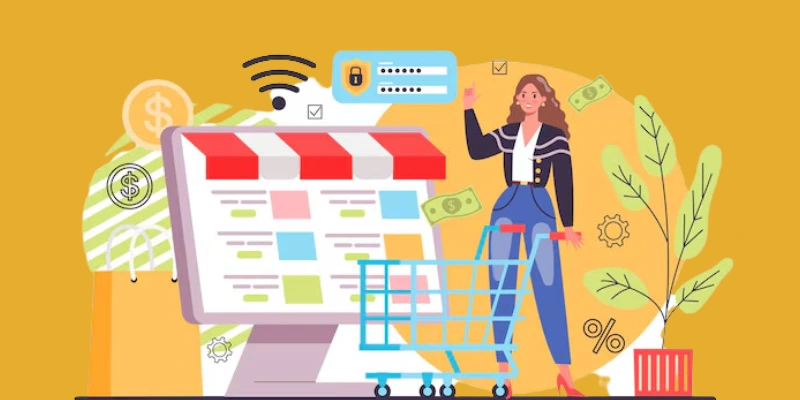In the bustling landscape of eCommerce website development, where a single click can lead you to make a sale, there is a massive need for eCommerce apps that are both interesting and useful. Online shopping's rapid growth has changed the retail environment, pushing companies to come up with new ideas and adapt to the digital shift.
These days, shopping is more than just a chore. With just a tap of the finger, buyers can look at, choose, and buy items. When you combine ease and luxury in eCommerce apps, you get a world of options. One of the most popular eCommerce apps in Australia, Ozsale, shows how this change has happened by attracting users with its unique and attractive features. When you build an eCommerce app like Ozsale, you're not just following the latest trends; you're creating them. It's all about giving your customers a smooth and enjoyable shopping experience that sticks with them.
Statista says that the Australian eCommerce market will continually bring in more money from 2024 to 2029, by a substantial $20.9 billion, or 56.33% more than the previous year. The market is expected to hit a new high point of $58.03 billion in 2029, following a growth trend that has been going on for seven years in a row.
Market growth is attained due to aspects like web penetration, consumers' dependability on online shopping, and the ease offered by eCommerce website development services. Furthermore, the extensive use of smartphones and mobile apps has made internet shopping more readily available, therefore growing the industry.
If you are an eCommerce development company trying to take advantage of this expansion, your initial idea revolves around the costs involved in creating an app like Ozsale. Although the initial outlay for developing an eCommerce app may seem high, over time, the benefits exceed the expenses.
Based on the complexity and nuances of the whole development process, the cost of developing an Ozsale-like app would range from $40,000 to $300,000. With the proper mix of features and capabilities, an eCommerce app can become an empowering medium for increasing sales, improving consumer involvement, and expanding your business's position in the digital scene.
In this blog, we shall investigate Ozsale, learning what it is, how it operates, and the elements influencing the development cost of a similar application. We will also explore its salient features, the processes involved to develop an eCommerce app like Ozsale, and its income sources.
What is Ozsale?
Established in 2006 in Sydney, Ozsale is a well-known eCommerce platform nowadays. Focused initially on offering daily sales events with significant discounts on many products, the app became very prominent in a short period of time. This approach and commitment to providing high-quality products have helped the company establish itself as a trustworthy online retailer and expand at a rapid pace.
In 2010, Ozsale was bought by APAC Sale Group. It provided the company with the knowledge and funding required for expansion. This led to a significant transformation of Ozsale so that it could include fresh features and services that enhance the user experience. At present, Ozsale is among the top online shopping portals in Australia and offers a range of goods in different categories, such as decor, beauty, fashion, lifestyle, and electronics. The brand is dedicated to innovation and works to introduce new products and offerings in return for the dynamic requirements of the user base, despite its growing success.
With global net sales exceeding $31.8 million in 2023 and total funding of $14.5 million, Ozsale aims to make online shopping simple and pleasurable for its consumers throughout Australia. Given these outstanding results, investing in the development of a similar app will help an eCommerce website development company like yours realize maximum benefits.
Overview of the Top Features of an App Like Ozsale
Flash Sale Mechanism
The flash sale mechanism of an app like Ozsale defines its core. With limited-time offers on several products, it generates enthusiasm and urgency. A precise countdown meter, an indicator of limited supply, and alerts for sold-out items are fundamental components. To maintain user involvement, the platform should also allow several simultaneous sales across several product categories.
Customer Profile
A strong user profile system improves the buying experience. Users should be able to manage personal information, establish accounts, and keep an address book for quicker checkouts. While wish lists let customers save things for future use, order history offers a unique approach to monitoring past purchases. Personalising is essential; the app suggests goods depending on user preferences, buying behaviour, and browsing history.
Product Navigation
Product discovery depends on a user-friendly interface, of course. While a strong search engine lets users search for certain products or brands, clear classification helps consumers find desired goods quickly. Filters on price, size, colour, and other criteria show search results accordingly. Thorough product information, including premium photographs and descriptions, is essential for informed buying decisions.
Safe Payment and Checkout
Customer happiness depends critically on a safe and easy checkout system. Several payment choices, including credit cards and digital wallets, fit different customer preferences. Sensitive client data is kept safe using a secure payment gateway. For those who would choose not to register an account, the guest checkout option gives them freedom. Detailed information and immediate order confirmation guarantee openness and strengthen confidence.
Push Notifications
Push notifications keep consumers informed about app alerts regarding forthcoming or live flash sales that generate a buzz. Notifications about order status, like updates on shipment and delivery, offer peace of mind. Customised product recommendations based on user behaviour improve the purchasing experience. The software should provide a choice allowing users to change their preferences for notifications.
Customer Ratings
Customer ratings and reviews help establish trust and affect buying choices. Allowing users to contribute their ideas and experiences will help create a community. A star-scale rating system offers fast comments on product quality. Moderation of reviews guarantees that the material is suitable and valuable. Emphasizing products with favourable ratings and reviews will help increase sales.
Loyalty Scheme
A loyalty program inspires current involvement and honours returning consumers. A points system based on purchases, recommendations, and other activities can encourage customer loyalty. Customised rewards depending on consumer preferences and exclusive offers help build the relationship with the customer.
The process to Develop an eCommerce App Like Ozsale

In order to come up with software similar to Ozsale, you should abide by a consistent and stepwise procedure, guaranteeing that each step contributes to an engaging consumer experience. Here is a thorough manual on creating a competitive app:
Commence Market Research
Start with extensive market research to grasp the competitive climate and preferences of your target audience. Determine what distinguishes Ozsale and consider how to improve or incorporate such qualities into your own app. Examine market trends and consumer behaviour to find opportunities and close gaps.
Outlining the needs, schedule, scope, and eCommerce website development cost will ensure that your thorough development project plan satisfies your company objectives and market needs. A SWOT analysis can provide insightful knowledge on the prospects and hazards of your app idea. Because of this careful strategy, the subsequent phases of growth will have a solid basis.
Define Requirements and Features
Draft a detailed list of features for developing your app. Some core functionalities include item listings, search abilities, customer registration, payment methods, the shopping cart, consumer service, and order tracking. Your app will stand out from the others with advanced features such as chatbot integration, tailored recommendations, 3D product modelling or AR-assisted product demonstration.
Be Mindful of the UI/UX Design
Work with skilled UI/UX designers to create an aesthetically beautiful and intuitive design. Look at simple navigation, visually pleasing layouts, and consistent branding. Create mock-ups and wireframes to show the app's structure and features; then, user testing will provide the required assistance to enhance the design.
Work on Frontend and Backend Development
Create the databases, servers, and APIs required to enable the functionality of the program. Guarantee perfect compliance with data security policies and regulatory guidelines. Start frontend development concurrently to create the user interface, then easily link it with the backend operations.
First, prioritize the application of basic features; after that, consider integrating sophisticated features. Build and test features iteratively using agile development techniques to guarantee they meet consumer expectations. Work closely with the design and testing teams to guarantee seamless integration and functionality in all facets of the application.
Incorporate Third-Party Services
Add important external third-party services, including analytics tools, consumer support systems, and gateways such as PayPal and Stripe. Make sure every integration works perfectly to give users a flawless experience. Frequent updates to these integrations also help to preserve dependability and performance.
Testing and Quality Assurance
Perform quality assurance to detect and resolve defects, guarantee compatibility among several platforms and devices and validate functionalities. Use end-to-end, integration, and unit testing as among the automated and manual testing tools. Invite real people to beta test to gain smart feedback, solve issues, and ensure the app is updated before it's launched.
Release the App
Launch the app on a few chosen sites, like the Google Play Store and App Store. Exactly monitor its functioning, responding quickly to user comments and reviews. Use analytics to track user behaviour, engagement, and other key indicators to guarantee the app's performance and point out areas that might need improvement.
Maintenance Post-Launch
Support and maintenance should be provided constantly to guarantee timely answers to user questions and problems. Respond to customer comments and market trends by routinely updating the app to improve performance and add fresh features. Track the app's scalability and performance constantly to ensure it can satisfy a rising user base. Remember that these initiatives could affect the general expenses of creating an app like Ozsale.
Revenue Models for an App Like Ozsale
Affiliate Revenue
Under the affiliate income model, one earns commissions by advertising outside-of-house products or services. On its website, an e-commerce platform embeds banners or affiliate links. With every click on the links and consequent purchase, a commission is generated based on the sale. This model has the underlying meter of monetizing already existing user traffic for passive earnings, with no dealing in inventory or transactions.
Advertising Revenue
The advertisement revenue model generates money through the sale of ad space on platforms, whereby businesses pay for their ads to appear before users, whether banners or sponsored content. Many formats are used, and earnings are gained from the revenue in both PPC and PPI methods. This model provides an excellent source of stable income since targeting can be done for any demographic of users. More efficient ads bring increased revenues.
Freemium
The Freemium Model does not charge users anything for any basic level of access; it, however, charges users for advanced features or services. Core functionality could be free, with premium features, advanced tools, or elevated support paid for. This will provide high volumes of users and opportunities to upsell premium features. Success depends on creating compelling offerings that drive free users to upgrade to paid plans.
Subscription
The subscription model means that users or sellers will pay a recurring fee for special features or services. These include special content, extra functionality, and an ad-free experience, among many others. The model creates reliable revenue streams while creating loyal customers. The value created by the platform should justify the subscribers' recurring charges. The pricing tiers are flexible to accommodate the needs and preferences of different users.
Online Advertising
Online advertising creates revenue through many digital ad formats, be they display ads, video ads, or native ads placed within a platform. Advertisers get space to promote their products or services to the platform's audience. Models like cost-per-click or cost-per-impression can generate such revenues. Ad revenue for online advertising is garnered from targeted ad opportunities via user traffic and engagement on that online platform.
Sponsorship
In the sponsorship model, the platform teams up with brands or companies to have certain content or features sponsored on the site. Sponsors will pay to be shown in regard to some particular events, categories, or promotions. This model opens up an extra revenue source while enhancing brand visibility and credibility. Examples include sponsored events, exclusive content, or branded areas of the site. Success will depend on the compatibility between the sponsorships, the interests of the users, and the platform values.
Membership Programs
Membership programs generate money from users through subscriptions by giving them special membership plans with exclusive access or special benefits. This may be in the form of discounts or early bird access to products, special content, etc. In such models, there should be enough incentives for the users to become members and stay retained. One may introduce tiers so that the benefits are tailored to the customer, whereby there will be a variety of offers so that no user goes unengaged.
Aspects Impacting the Total Cost to Build an eCommerce App Like Ozsale
App Complexity
When considering how much it costs to build an eCommerce app like Ozsale, one of the most important aspects is its complexity. A lot of time and money will be needed if there are too many capabilities to have them all. A perfect example is the Ozsale app, which has various features such as wishlist management, real-time push notifications for promotions and updates, secure shopping cart functionality, integrated payment gateways, and product browsing with fine filtering choices.
Moreover, each feature you add increases the complexity of development, requiring more effort on the part of the developers. As a result, building an app similar to Ozsale with additional features can be quite expensive.
Design Complexity
The success of an app similar to Ozsale relies on its UI/UX design, which should mandatorily be attractive and easy to use. An attractive or simply navigable design demands professional designers and coders which can pose a huge impact on finances. Custom animations and visuals extend the development time and raise the cost of Ozsale, even if they enhance the user experience. Well-designed software guarantees users will interact with it appropriately, therefore promoting loyalty and constant use. This addresses user flow, visual aspects, and the overall journey.
Scalability
The cost of developing an eCommerce app such as Ozsale is highly dependent on its scalability. A solid infrastructure, cutting-edge technologies, and some level of foresight are needed when building an application that can support a rising number of users, transaction volumes, and product portfolios. A scalable architecture ensures that the application can grow together with the firm, implying reduced performance issues and minimal chances of the app's downtime.
Choice of Platform
When deciding how much it will cost to create an eCommerce application similar to Ozsale, the choice between iOS, Android, or cross-platform applications needs to come into play. Overall, developing an application for just one platform is cheaper than considering both the iOS and Android platforms at the same time. Alternatively, certain frameworks allow cross-platform development, such as Flutter, which allows for concurrent reaching a wider audience through multiple platforms. Apart from this, the integration of a web platform could also increase the price of building the Ozsale app.
Integration Requirements
Integration needs have a big influence on the expenses of developing an Ozsale app. Integrating with current systems or outside vendors like inventory control, CRM, or shipping providers adds complexity and calls for a specific time for creation, extensive testing, and continuous maintenance. This might call for ongoing efforts at development and maintenance.
Every integration brings possible difficulties that increase the general cost of eCommerce development. Still, it's important to know how well the software works since seamless integration defines its user experience.
Size and Location of the Development Team
The size and structure of an eCommerce application like OzSale's development team significantly influence its cost of development. A typical team usually comprises a project manager, UI/UX designers, front-end and back-end developers, quality assurance testers, a DevOps engineer, and a business analyst. Hiring dedicated developers who are part of a large team will thus help you distribute the work, have experts in every field, and also reduce the time required to produce your product.
The location is the key factor affecting the total development cost of the app. Usually, developers in North America or Europe charge more than those in Eastern Europe or Asia. If you hire remote developers or outsource skillset from areas like Asia, it is fairly possible to offer reasonably priced solutions without compromising quality. Budget adherence and project deadline achievement depend on effective team collaboration and management.
Safety Considerations
Any app's first concern is security, but for eCommerce systems, managing private user information and financial transactions is even more important. Strong security measures are required to protect user privacy and trust, even if they increase the cost of creating an eCommerce application like Ozsale. Among the security consideration strategies are regular security audits, secure authentication, and encryption.
Investing in robust security measures also helps to assure compliance with industry standards and regulations, therefore increasing user confidence, brand reputation, and protection against data breaches.
Final Thoughts
In conclusion, building an eCommerce application such as Ozsale requires an amalgamation of creativity, technical know-how, and an understanding of the market. However, although the initial investment may seem exorbitant, the inevitable profits in sales increase, customer retention, and business expansion justify its cost. The main factors that determine price are diversity of application, design, scalability, platform selection, and size, as well as the geographical location of the software developers’ team. Moreover, engagement with third-party service providers and the establishment of high-level security protocols are highly significant for success.
Focusing on things such as flash sales, personalized profiles, or secure checkout procedures will allow you to build a powerful app that improves shopping patterns. Thus, with good strategy and implementation, you, as an eCommerce development company, can flourish in the spirited Internet sphere, providing clients with an easy and exciting way to make purchases.












Share this blog